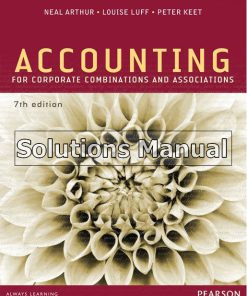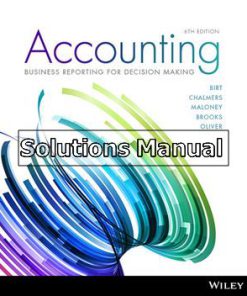Accounting An Introduction 6th Edition Atrill Solutions Manual
You may also like
Accounting An Introduction 6th Edition Atrill Solutions Manual

Product details:
- ISBN-10 : 0273771833
- ISBN-13 : 978-0273771838
- Author:
This successful text provides a comprehensive yet balanced introduction to financial accounting, management accounting and the basics of financial management. The text is specifically designed for non-specialist students, explaining the fundamental principles clearly and concisely, whilst showing how accounting information can be used to make decisions in a real business context.
Table contents:
- 1.1 Definition of accounting
- 1.2 First: A bit of history
- 1.2.1 The first accounting records
- 1.2.2 Who was responsible for the creation of the double entry system?
- 1.2.3 What is this book about?
- 1.3 Demystifying the jargon
- 1.4 The environment of accounting
- 1.4.1 The purpose of an economic system
- 1.4.2 Money as a unit of exchange
- 1.4.3 The financial system
- 1.5 Business organisations
- 1.5.1 Classification of business by activity
- 1.5.2 Setting up a business
- 1.5.3 Operating a business
- 1.6 The purpose of accounting
- 1.6.1 Why is it necessary to create a record of transactions in a business?
- 1.6.2 Who are the economic decision-makers, and what decisions do they need to make?
- 1.6.3 What information will assist people in making economic decisions?
- 1.6.4 How is financial information communicated?
- What have we learnt in this chapter?
- What’s next?
- 2 The purpose of accounting
- Learning objectives
- 2.1 Key financial decisions
- 2.1.1 Financing decisions
- 2.1.2 Investing decisions
- 2.1.3 Operating decisions
- 2.1.4 Distribution decisions
- 2.2 Understanding the statement of financial position
- 2.2.1 Understanding more about assets
- 2.2.2 Understanding more about liabilities
- 2.2.3 Understanding more about equity
- 2.3 Understanding profit or loss and comprehensive income
- 2.3.1 Income and expenses
- 2.3.2 Understanding accrual
- 2.3.3 Understanding profit
- 2.4 An introduction to statement of changes in equity
- 2.5 Understand the statement of cash flows
- What have we learnt in this chapter?
- What’s next?
- Questions
- 3 The practice of accounting
- Learning objectives
- 3.1 The accounting equation in more detail
- 3.2 The double entry principle
- 3.3 What are source documents?
- 3.3.1 Deposit slip
- 3.3.2 Loan application
- 3.3.3 Cheques
- 3.3.4 Internet banking
- 3.3.5 Cash receipt
- 3.3.6 Credit sales/credit purchases invoice
- 3.4 Journal entry
- 3.5 Recording information in the general ledger
- 3.5.1 What is the general ledger?
- 3.6 Extracting a trial balance
- 3.7 Closing entries
- 3.8 Reviewing the accounting cycle
- 3.8.1 Source documents
- 3.8.2 Journal entries
- 3.8.3 General ledger
- 3.8.4 Trial balance
- 3.8.5 Financial statements
- 3.9 How do specialised journals form part of the accounting cycle?
- 3.9.1 Cash Receipts journal
- 3.9.2 Cash Payments journal
- 3.9.3 Purchases journal
- 3.9.4 Sales journal
- 3.10 Pulling it all together
- What have we learnt in this chapter?
- What’s next?
- Questions
- 4 The conceptual framework
- Learning objectives
- 4.1 Generally accepted accounting practice
- 4.2 The objective of financial reporting
- 4.2.1 Who are the primary users of financial statements?
- 4.2.2 Who else would be interested in the financial statements?
- 4.2.2.1 Customers
- 4.2.2.2 South African Revenue Services (SARS)
- 4.2.2.3 Employees
- 4.3 The going concern assumption
- 4.4 Qualitative characteristics of useful financial information
- 4.4.1 Fundamental qualitative characteristics
- 4.4.1.1 Relevance
- 4.4.1.2 Faithful representation
- 4.4.2 Enhancing qualitative characteristics
- 4.4.2.1 Comparability
- 4.4.2.2 Timeliness
- 4.4.2.3 Verifiability
- 4.4.2.4 Understandability
- 4.4.3 Will financial information always have all of the enhancing qualitative characteristics?
- 4.5 Elements of the financial statements
- 4.5.1 Assets
- 4.5.2 Liabilities
- 4.5.3 Equity
- 4.5.4 Income and expenses
- 4.6 Recognition criteria for the elements
- 4.7 Derecognition of assets and liabilities
- 4.8 Measurement bases
- 4.8.1 Historical cost measurement
- 4.8.2 Current value measurement
- 4.8.2.1 Fair value
- 4.8.2.2 Value in use (assets) and fulfillment values (liabilities)
- 4.8.2.3 Current cost
- 4.8.3 Deciding which measurement base to use when initially recognising an asset
- 4.8.4 Subsequent measurement
- 4.9 The accrual concept
- What have we learnt in this chapter?
- What’s next?
- Questions
- 5 Adjustments
- Learning objectives
- 5.1 Processing adjusting entries
- 5.1.1 The accounting process
- 5.2 Closing entries
- 5.3 Understanding adjusting entries
- 5.3.1 Accrued expenses
- 5.3.2 Prepaid expenses
- 5.3.3 Income accrued
- 5.3.4 Income received in advance
- 5.3.5 Depreciation
- 5.3.6 Bad debts
- 5.3.7 Allowance for doubtful debts
- 5.4 Let’s pull it all together
- 5.5 Reversal of adjusting journal entries
- 5.5.1 Reversals for prepaid expenses
- 5.5.2 Reversals for accrued expenses
- 5.5.3 Reversals for income received in advance and accrued interest
- What have we learnt in this chapter?
- What’s next?
- Questions
- 6 Inventory
- Learning objectives
- 6.1 What is inventory?
- 6.1.1 Definition of inventory
- 6.1.2 Why is inventory an asset?
- 6.1.3 When is inventory recognised as an asset?
- 6.2 Calculating the cost at initial recognition
- 6.2.1 Definition of “cost of inventory”
- 6.2.2 So what is included in the cost of inventory?
- 6.2.3 The impact of trade discount and settlement discount on the cost of inventory
- 6.3 Recording inventory in the general ledger
- 6.3.1 Inventory recording systems: perpetual versus periodic
- 6.3.2 Recording inventory transactions in the general ledger
- 6.4 Cost allocation methods − subsequent measurement of inventory
- 6.4.1 The FIFO cost allocation method
- 6.4.2 The weighted average cost allocation method
- 6.4.3 Cost allocation methods − sales returns
- 6.4.4 Cost allocation methods − purchase returns
- 6.5 De-recognition of inventory
- 6.6 Disclosure of inventory in the financial statements
- 6.7 Selling price and cost price in more detail
- 6.7.1 Understanding the difference between the stated mark-up and the actual gross profit
- 6.7.2 Determining the selling price
- What have we learnt in this chapter?
- What’s next?
- Questions
- 7 Value added tax (VAT)
- Learning objectives
- 7.1 What is VAT?
- 7.1.1 Tax invoice
- 7.2 When does a business register as a VAT vendor?
- 7.3 How is VAT calculated?
- 7.4 How does the VAT system work?
- 7.5 Is VAT another tax that my business must pay?
- 7.6 How does VAT affect the records of a business?
- 7.7 Recording VAT
- 7.7.1 The general journal
- 7.7.2 The general ledger
- 7.7.3 The trial balance
- 7.7.4 Statement of comprehensive income for the year ended 31 January X1
- 7.7.5 Statement of financial position as at 31 January X1
- 7.8 VAT and inventory
- 7.8.1 VAT and the perpetual system
- 7.8.2 VAT and the periodic system
- What have we learnt in this chapter?
- What’s next?
- Useful web sites
- Questions
People also search:
Accounting An Introduction 6th
Accounting An Introduction 6th pdf
Accounting An Introduction 6th pdf free
Accounting An Introduction 6th download scribd
Accounting An Introduction 6th edition












